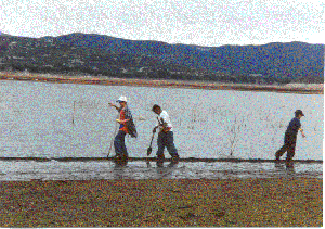
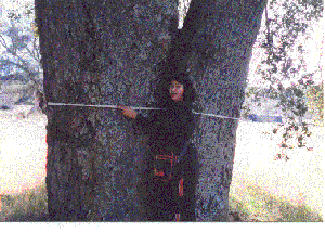
Explorer's Club: Science Program for Reservation Children
By
Eleanora
Robbins and Edited by Roy Cook
Explorer's Clubs are on four reservations in San Diego County: Pala, Jamul,
Campo, La Jolla. The purposes of this free monthly program are many: nourish
interest in love of outdoors, introduction to outdoors science as a career,
share the values that protect the earth, and to provide outdoors scientists as
role models. The program is the brainchild of Dr. Eleanora (Norrie) Robbins, a
geologist who retired in 2001 from the U.S. Geological Survey (USGS) in the
Washington, DC area. She is now adjunct faculty at San Diego State University.
The
activities are designed for children, 6-12 year old. These include: exploring
the four directions, collecting rocks, discovering what people add to the
streams, digging to learn about soil and underground water, panning for gold and
minerals, learning outdoors photography skills, and hunting for lizards. The
children are free to roam, get wet and dirty, and to make observations; if they
don't think they are having fun, they vote with their feet.
Norrie Robbins was concerned that she rarely met Native American scientists in
her 36 year career with the Federal Government. Social Worker Mona Osbourne,
Pawnee, BIA-retired, taught her that children on Tribal reservations often meet
social workers and lawyers but rarely scientists. So Norrie decided to
demonstrate by example and be a scientist around Native American kids.
Additionally, she wanted to bring this opportunity a Native American Tribal
reservation.
One recent formal activity included participating in National Water Monitoring
Week, Oct. 18, 2002. EPApersonnel from five reservations joined in to teach the
six to twelve years of age children how to keep water safe and to measure water
quality.
Tribal
Education Directors on each reservation structure their programs individually.
Some feed the children lunch or snacks, and some provide a van and driver to
transport the children. Their funding is through MESA, JOM, or Head Start Boys
and Girls Clubs. Some request an hour after school programs and some reserve a
longer block of time on Saturday. Future proposed urban meetings of the Explorer
Club may include trips to traditional village sites in San Diego city: Old town,
Balboa Park, Mission Valley and so on. These meetings continue to hold the
promise of increased awareness of tradition and the positive encouragement of
self esteem. More volunteer biologists and Tribal elders are needed. She is
inviting, with tribal encouragement, other scientists from San Diego State
University, United States Geological Survey, Santa Ana Water Quality Review
Board, and Palomar College.
If you would like to help organize a program on your reservation or community
contact: norrierobbins@cox.net.
These photographs will demonstrate a diversity of participants, including some
from the urban area.
 |
 |
| Campo children exploring the mudflat around the shore of shrinking Lake Morena. | Danika Cuero (Campo) measuring diameter of oak tree to learn how to assess: age, distribution and properties of this important traditional food source. |
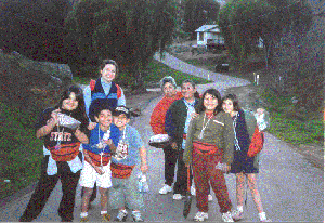 |
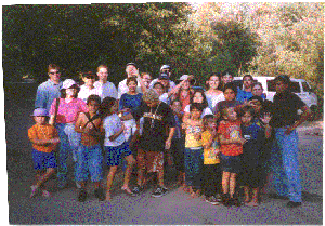 |
| Jamul children with their rock and mineral collections. | La Jolla children, organized by Elder Henry Rodriguiz, at La Jolla Campground utilized the USGS mobile lab and measured water quality for National Water Monitoring Week. |
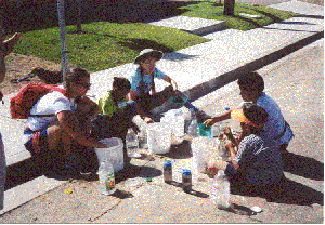 |
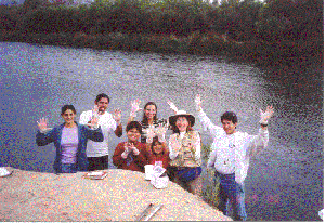 |
| Southeast San Diego children used buckets and water bottles to pan for gold and magnetite. | Pala children, EPA personnel, and SDSU students measured water quality at the Pala Casino pond for National Water Monitoring Week. |
|
|
Final thoughts by Roy Cook |
![]() We
can forget about neurochemistry. (A dream showed Nobel prizewinner Otto Lowei
that the chemical messengers, we now call neurotransmitters, are responsible for
the flow of information in the human brain.) We can write off pasteurization,
penicillin, and hundreds of other modern discoveries and inventions. for
example: Alexander Graham Bell used intuitions that he called "a conquering
force within" to invent the telephone and Henri Poincare, the mathematician who
created the science of topology, said, "It is through science that we prove, but
through intuition that we discover."
We
can forget about neurochemistry. (A dream showed Nobel prizewinner Otto Lowei
that the chemical messengers, we now call neurotransmitters, are responsible for
the flow of information in the human brain.) We can write off pasteurization,
penicillin, and hundreds of other modern discoveries and inventions. for
example: Alexander Graham Bell used intuitions that he called "a conquering
force within" to invent the telephone and Henri Poincare, the mathematician who
created the science of topology, said, "It is through science that we prove, but
through intuition that we discover."
2. Holding American Indians to a narrower definition of the scientific discovery
process than is used for Europeans is unfair scholarship.
American Indians did not know about the scientific method, so their knowledge and inventions could not be scientific. Europeans didn't use it either because it hadn't yet been invented. Historical researchers seldom mention this critical fact.
Most scholars credit Francis Bacon, an English philosopher and statesman who lived from 1561 to1626, as the father of the scientific method. Sometimes Galileo, an astronomer, who lived from 1564 to 1642, is also credited. Both were born well after Columbus landed in the Americas. The fact that Galileo was arrested by the Catholic Inquisition in 1633 for heresy and held prisoner until he died in 1642 indicates that the scientific method was not only unwelcome in Europe for at least 150 years after 1492 the scientific method was considered a sin and a crime.
Insisting that pre-contact American Indians ought to have used the scientific method before it existed is irresponsible and sloppy scholarship.
It can be
difficult to detect because it often omits critical facts about both American
Indian and European history. The fact that these articles and books are
frequently written by well-respected scholars and authorities makes it even more
difficult to detect. Like a low-grade infection, it works below the level of
awareness, affecting students from elementary school to graduate school.
Thanks to: Kay Marie Porterfield for excerpts.